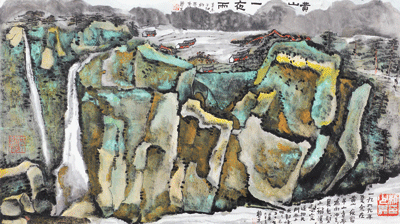 Wang Haiying why.art@163.com YEAR 2015 marks the centennial birthday of Lai Shaoqi, a Chinese painting master and pioneer from Guangdong. As a modern painting master, Lai (1915-2000) was a rare, versatile, artistic genius with extraordinary achievements in printmaking, ink and wash painting, calligraphy, seal-cutting, poetry and playwriting. In 1991, he was awarded the “Prize for Outstanding Achievements” by the China Artists Association and the China Printmaking Artists Association at the Great Hall of the People in Beijing. To celebrate Lai’s centennial birthday, a series of programs have been organized this year around China. Among them, an exhibition entitled “Exhibition of Lai Shaoqi’s Printmaking Art” is currently on display at the Guangzhou Museum of Art. The museum established the Lai Shaoqi Gallery in 2000, which is home to a large collection of Lai’s ink and wash paintings that are routinely put on display. The documentary exhibition is presenting Lai’s prints that were made both and after the founding of the People’s Republic of China and precious texts and documents. With an audio guide and major texts in English, the exhibition also shows the relationship between Lai’s prints and ink and wash paintings. In addition to the exhibition of Lai’s works, a large catalog entitled “The Mystery of Greatness: A Collection of Works by Lai Shaoqi” was edited by the Guangdong Museum of Art earlier this year. This is the largest collection of Lai’s works that has ever been published, and it is valuable for researchers of his art. With excellent printing quality and more than 700 full-color pages of Lai’s works, including his ink and wash paintings, woodcuts, sketches and calligraphy, this catalog provides an outline of Lai’s greatest achievements in diverse art mediums as well as his rich personality. Lai had been a pioneer in creating new and distinguished painting styles and art forms. Many believe that his art will offer rich inspiration to future generations of artists. “Lai Shaoqi is one of the four leading painting masters in China in the 20th century, the other three masters being Huang Binhong (1864-1955), Li Keran (1907-1993) and Fu Baoshi (1904-1965),” said Chen Chuanxi, a professor at Renmin University of China and one of the leading researchers. As a Guangdong native, Lai studied art at the Western Painting Department of Guangzhou Art School from 1932 to 1936. During this time, he was one of the leading artists in the progressive movement of “modern woodcut creation” advocated by the great Chinese writer Lu Xun. In his letters to Lai, Lu Xun expressed his appreciation of the series of excellent woodcuts created by Lai, which were carved with vigorous lines and concise shapes as well as strong spiritual power and called for the public to protect the motherland in the war of resistance against Japanese aggression. One of his representative woodcuts made in the 1930s is “Portrait of Lu Xun.” The forceful straight lines of the figure’s eyebrows, mustache and hair effectively express the writer’s firm and unyielding nature. Lai was an editor of several woodcutting magazines, and he organized a series of woodcutting exhibitions to support the war of resistance. He joined the New Fourth Army in 1939 and made outstanding achievements as an artistic leader in the army in the 1940s when he encountered heart-stirring adventures and wrote poems and drama scripts to encourage the army. After the founding of New China, Lai was elected as the chairperson of the art and literature circle of Anhui Province. By reviving and promoting the tradition of ancient Anhui printmaking art, he and his students and partners created New Anhui Printmaking School, which was influential in China in the 1960s and 1970s. In 1980, Lai was elected as vice chairperson of the China Printmaking Artists Association. Apart from ancient printmaking art in Anhui, Lai also admired many of the ancient landscape painting masters of the province such as Cheng Sui (1605-1691) and Dai Benxiao (1621-1691). So Lai began practicing the techniques of traditional Chinese painting in the 1950s by closely studying the original works of the ancient masters. Acquiring the essence of Chinese landscape painting, Lai frequently made ink and wash sketches on Huangshan Mountain and produced a large amount of ink and wash paintings that realistically represent various features and changeable characters of the mountain, presenting the magnificence of the towering mountain. When he retired in 1986, Lai returned to Guangzhou. Having accumulated rich experiences in art and life, he decided to change his style to adapt to the new era and the new living environment in the south. He painted the landscapes more subjectively and freely instead of realistically, boldly combining the essence of traditional Chinese painting and printmaking art as well as the key elements of modern Western painting. Gradually, his ink and wash paintings became more and more concise in form but contained the profound and intensive charm of nature and the infinite richness of the spiritual world. | 
